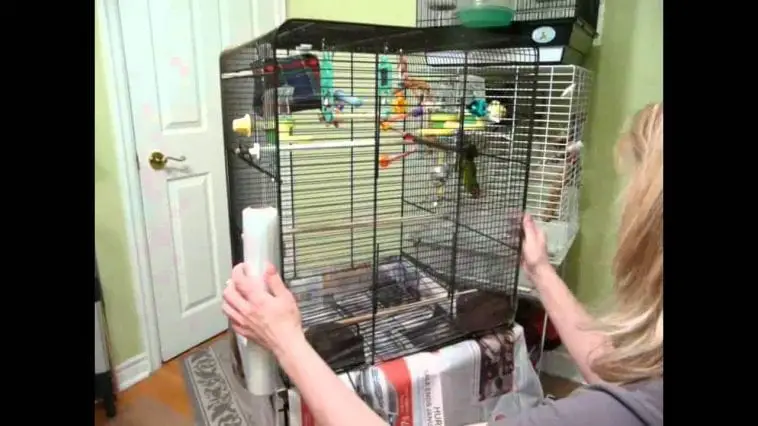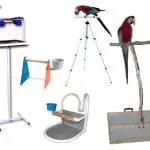There is no better way to start the New Year than with a fresh, clean slate that will keep you flying high all the way. Besides a list of things to Marie Kondo around you to begin the year, even our own feathered-friends need to have a home that will keep them in a clean bill of health and tweeting happy tunes. So how do you clean the cage of your lovely bird to maintain health and avoid him from contracting disease caused by a dirty cage?
So, here are some gathered tips and tricks that are practical and hassle-free to help maintain your bird’s cage and won’t hurt your budget. Let this guide serve as your reference so you can make your pet bird happy and healthy. Let’s get started!
Gather Your Tools
First, store cleaning tools and supplies in a convenient area. Make sure that you also keep the storage clean and dry. You can put these items in a cabinet, shelf, or container solely for your bird’s needs. To tidy up the cage, you can look around the house or check your local grocery for the following:
- Newspaper or scratch paper as cage lining
- Brushes such as a scrub brush, kitchen brush, or a toothbrush.
- A scrubber-backed sponge, kitchen sponge, or loofah scrub sponge
- Cleaning cloths
- Mild dish soap
- Baking Soda
- Table Vinegar
Frequency of Cleaning Your Bird’s Cage
It is important to know how often you need to clean accessories, dishes, and feeders, and the whole cage. The dishes or feeders and the birdbath (if you have one) need to be cleaned daily. Rinse off under hot water all the grime and scrub thoroughly. Use mild dish soap to cleanse then dry completely.
Although there are bird cage cleaners available at pet stores. Veterinary technicians recommend that soap and waterworks better rather than the expensive cleaners you’ll find on shop shelves. Dish soap is also safer for birds as they can be sensitive to strong scents and toxic fumes. If you do not have the time to wash the dishes, keep an extra clean set ready to change them with.
Video Source: Youtube
Daily Cleaning
The cage liner is changed daily as well. Here’s how:
- Pull out the scale below the cage and remove the soiled liner.
- Wipe off droppings and food on the scale and clean it like the feeders. You can also use a half-and-half mixture of table vinegar and baking soda to disinfect the scale.
- Let it dry out before replacing the lining with newspaper or scratch paper. This cleaning process also applies to the perches if you notice and droppings or food stuck on them. While cleaning all of the items mentioned, the bird may stay inside the cage.
Important Considerations When Cleaning a Bird Cage
1. Bird Cage Size and Number
The number of birds and the size of the cage will determine how often the whole cage needs to be cleaned. A small cage with one bird may only need cleaning once a month, while a big cage with several birds might be cleaned every week.
Just keep an eye out if there are any droppings or food building up that you need to get rid of immediately. Leaving any gunk or food in the cage for too long can make your bird sick. If you have an extra clean cage, transfer your bird before cleaning.
2. Nozzle Size of Water Bottle
The key to choosing the proper water bottle should take into consideration the nozzle size and your cage. The nozzle size of the water bottle is the most important consideration to ensure that your bird will get enough water without wasting it.
A water bottle that works based on the principle of “Vacuum-Valve” can be used. It uses a stainless steel metal ball that bears inside the tube, which is able to hold water. Because of the vacuum formed inside the bottle (sealed by a cork), the water is not wasted. When your pet’s beak or tongue moves the exposed ball, then the seal is broken. The vacuum inside the bottle is released to allow water to flow and finally hydrate your bird.
3. Consider Using Bird Cage Liners
While rolled paper or newspaper safely collect debris from a birdcage, you have to change it throughout the day. Otherwise, a great number of bacteria will harbor in the newspaper sheets. Choose bird cage liners that are treated with a naturally occurring element, a silver ion to inhibit the growth of odor and mildew that cause bacterial growth on the paper surface.
Bird cage liners come in different package sizes in easy to cut to sizes, in which the paper is conveniently marked for easy sizing. If bird cage liners cannot be accommodated by your budget, you can advocate it when you have newborn birds to avoid compromising their immune systems.
General Tips When Cleaning Bird Cage
- Keep windows closed if your bird is in an open space around the house. To clean the entire cage, wipe off dirt and droppings and hose it down, then rinse in hot water.
- For wooden surfaces, scour it with sandpaper. Scrub the grills with a brush or sponge. 3. For crevices and spots that are hard to reach, brush it with a toothbrush. Use the half-and-half mixture of table vinegar and baking soda to sanitize, followed by the mild dish soap. Let it dry completely or lay it under the sun to kill bacteria. The same process also works for toys and accessories.
- Disinfect your cleaning tools. Leaving your brushes, sponge, and rags wet can house bacteria that are harmful to the bird’s health. Rinse them in hot water, too, and dry before storing. Change the tools regularly.
- Don’t put dishes under bird perches.
- More pellets should be given along with fresh foods but fewer seeds.
- Using hulless birdseed blends is the best.
- Always place ceramic dishes on the bottom grille of the cage.
- Use a water vacuum r bottle instead of using a water dish to get rid of poop.
- Using a plastic chair floor protector under the bird cage or against the wall is a good idea.
- Cut or feed less millet into smaller pieces, placing in a dish on the bottom grille
- Use large paper sheets in the refuse tray rather than pine shavings or any loose bedding material.
- Place a stack of paper in the bottom of the bird cage and remove one sheet daily.
- Store your cleaning solution in a spray bottle to keep it handy and for easier application. Rotate the position of toys and accessories in the cage to keep your bird active and interested in playing with them. Now, your bird can return home and have fun in its neat crib.
Conclusion
Now you can make your bird’s home all tidy. With the above tips mentioned above, you’ll be more confident to clean your bird’s cage for a safe haven. Always keep this easy-breezy guide in mind the next time it’ll need cleaning. Like humans, your bird deserves a clean place to live and relax, so make sure to follow the right frequency, tips, and considerations when cleaning your bird’s cage so you and your bird will be happy and healthy.


